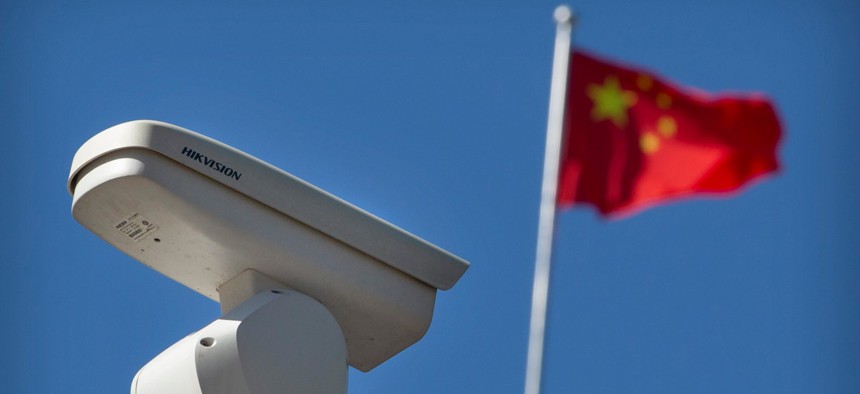
A Chinese flag flies near a Hikvision security camera monitoring a traffic intersection in Beijing, Tuesday, Oct. 8, 2019 Mark Schiefelbein/AP
U.S. Defense R&D Funding Falls As China’s Keeps Growing
2021 budget request would see Pentagon funding shrink from $64.5 billion to $59 billion.
At a time when China’s investment in research and development is growing, the Trump administration wants to rein spending in.
The Defense Department’s 2021 budget request includes lots of money for big next-generation tech priorities, such as $3.2 billion for hypersonic research; $1.5 billion for microelectronics and 5G networking; $1.7 billion for autonomy and an additional $800 million for the Joint Artificial intelligence Center. While U.S. research spending is decreasing, slightly, China’s is accelerating.
Across the government, the Trump administration wants to put $210 million into quantum sciences through the National Science Foundation and $25 million on the development of a national quantum internet.
That sounds impressive, but defense research and development spending would actually decline under the new request, from $64.5 billion in 2020 to $59 billion.
The story isn’t any better outside the Pentagon: Trump’s budget request would cut funding for basic science and research across multiple agencies. Overall, federal spending on civilian basic research would drop by 9%, or $13.78 billion, to $142.185 billion, according to Science.
Meanwhile, “China has more than tripled its basic research investments over the last decade while U.S. government investment has stagnated. In the long-term military competition with China, flatlining its S&T budget may make DoD a spectator as China turns leap ahead technologies into game-changing capability,” said Tara Murphy, CEO of data analytics firm Govini.
A Govini report released in January found that while total U.S. investment — government plus business — is still above that of China, the trend line favors Beijing, particularly in government spending.
“U.S. R&D spending has shifted toward later-stage research and was largely funded by business rather than government. The lack of growth within government-funded basic and applied research could have implications for the United States’ ability to pioneer groundbreaking technology,” the report said.
Between 1997 and 2017, China’s share of the global research and engineering budget grew 900 percent, from 3 percent to 27 percent, the report said.
“The best way to think about this [is that the United States and China] have very disparate models,” said Jim Mitre, Govini’s senior vice president for strategy and analysis. “The Chinese model, because it's a centrally commanded economy, is trying to break down barriers between the commercial sector and the public sector.” Mitre said China is “trying to extract the best from the public sector and find a military application for it. That is very different from our system. What that means is that the DOD and the U.S. government more broadly have to make more of an effort to find partners in the private sector to work more collaboratively.”

A graphic from Govini showing relative research and development spending between the U.S. and China
The Govini report notes that while Defense Department leaders are fond of saying that they’ve adopted a “startup mentality” and are finally reaching out to the country’s commercial technology innovation centers, places like Silicon Valley, Austin, and Boston, the vast majority of spending is still in places like Tampa and around Washington D.C. Moreover, traditional defense firms continue to dominate the spending.
On Monday, Army Gen. Mike Murray, the head of the U.S. Army Futures Command, discussed the difficulty of moving things from the startup space into the Defense Department.
“I can find a startup with a really interesting technology. Their ability to scale is [often] not there, so it's either going to be acquisition, or their [intellectual property] will be bought, or they will have to partner with a defense prime,” Murray said.
What does all of that mean for the future of the Defense Department’s startup outreach efforts? Said Govini’s Murphy: “The takeaway is that they have their work cut out for them.”
NEXT STORY: NASA Will Only Tolerate So Much Danger







